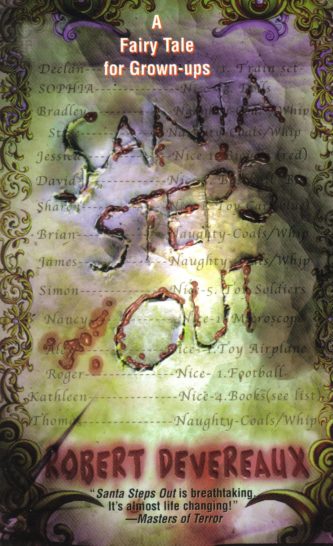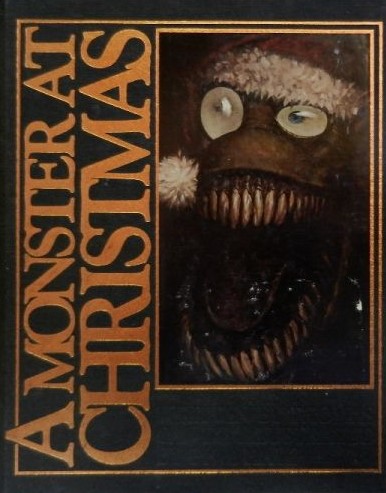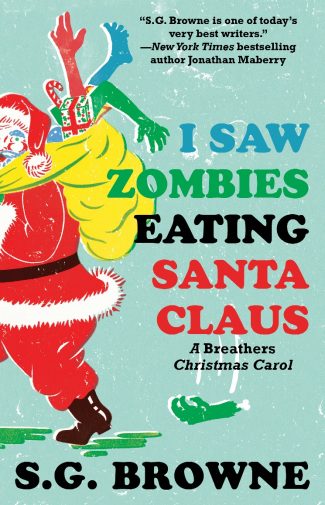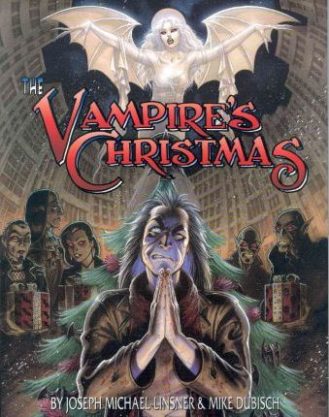I’m sure that by now most everyone is aware of the hallowed tradition of Christmas-themed horror cinema (a subject upon which I’ve been quite vocal), which has provided a wealth of classic horror films (BLACK CHRISTMAS, CHRISTMAS EVIL, GREMLINS) as well as quite a few not-so classic ones (with examples that are too numerous to go into here). But what of Christmas-themed horror fiction? In fact, there does exist such a tradition, and one, I’d argue, that’s as rich and varied as that of Yuletide horror cinema.
…the hallowed tradition of Christmas-themed horror cinema is a subject upon which I’ve been quite vocal…
 Such fiction stretches back to the 19th century, with 1831’s THE NIGHT BEFORE CHRISTMAS by Russia’s Nikolai Gogol. Picturesque and often downright bizarre, this uproarious novella displays a distinctly Russian sense of madcap surrealism in its breathless account of the devil stealing the moon on Christmas Eve. It seems a blacksmith residing in a small Ukrainian village painted a church mural that depicted the devil in an unflattering light, which pissed the Big D off to no end. It’s up to the resourceful townspeople (a broomstick-riding witch among them) to put a stop to the devil’s dastardly tricks.
Such fiction stretches back to the 19th century, with 1831’s THE NIGHT BEFORE CHRISTMAS by Russia’s Nikolai Gogol. Picturesque and often downright bizarre, this uproarious novella displays a distinctly Russian sense of madcap surrealism in its breathless account of the devil stealing the moon on Christmas Eve. It seems a blacksmith residing in a small Ukrainian village painted a church mural that depicted the devil in an unflattering light, which pissed the Big D off to no end. It’s up to the resourceful townspeople (a broomstick-riding witch among them) to put a stop to the devil’s dastardly tricks.
As enjoyable as it is, THE NIGHT BEFORE CHRISTMAS is not the finest Christmas-themed horror text. That honor, I contend, belongs to 1998’s SANTA STEPS OUT by Robert Devereaux. Subtitled “A Fairy Tale for Grown-Ups,” this incomparably demented treat has Santa Claus canoodling with the Tooth Fairy, much to the consternation of the Easter Bunny, who informs Mrs. Claus—who responds by stripping down and offering herself to Santa’s elves! There’s more insanity to come in this unerringly perverse yet elegantly written novel, which can be taken as a serious refutation of the seduction of childhood mythology (as David G. Hartwell argues in his introduction) or simply an X-rated tonic to all that mawkish spirit-of-Christmas crap we’re always force-fed around the holidays.
Devereaux followed up this triumph in 2008 with SANTA CLAUS CONQUERS THE HOMOPHOBES, in which Santa decides to stamp out homophobia. The book overall is far more message-oriented, and so less potent, than its more subversive predecessor, yet the perverse sensibility that powered SANTA STEPS OUT is still very much in evidence. Plus, in a very rare occurrence, it’s a Christmas story that’s concerned not with children but adults, and some mighty thorny real-life issues.
Another yuletide favorite is A MONSTER AT CHRISTMAS, written by Thomas Canty and illustrated by Phil Hale. The dark inverse of “The Night  Before Christmas,” it’s a genuinely horrific evocation of mirth and nastiness that recalls the Brothers Grimm at their grimmest, with a young boy bundled into a bag and hauled off by toothy monsters that emerge from his closet on Christmas Eve. The story is related in the form of extended poem, with memorable lines like “As your arms leave their sockets/With wet sucky pops!/And they pull off your ears/In two bloody red clots” that are well complimented by Hale’s artwork, done up in a classical Rockwellian style that nonetheless depicts some truly nightmare-inducing creations.
Before Christmas,” it’s a genuinely horrific evocation of mirth and nastiness that recalls the Brothers Grimm at their grimmest, with a young boy bundled into a bag and hauled off by toothy monsters that emerge from his closet on Christmas Eve. The story is related in the form of extended poem, with memorable lines like “As your arms leave their sockets/With wet sucky pops!/And they pull off your ears/In two bloody red clots” that are well complimented by Hale’s artwork, done up in a classical Rockwellian style that nonetheless depicts some truly nightmare-inducing creations.
The “Spirit of Christmas” is evidently quite a powerful thing, so much so that it inspired a number of horror scribes, specifically David Morrell, Joe Lansdale and Dean Koontz, to tone down their fictional approaches. See 1983’s children-oriented THE HUNDRED YEAR CHRISTMAS by David Morrell (not an author known for his sentimentality), which depicts Santa Claus at the end of a hundred year cycle in which he, as per tradition, climbs a hill and disappears into the mist blanketing its dark side. But before he does so Santa needs to nurture Father Time, who is born each New Years’ Eve and lives but a year, aging at an extremely accelerated rate—and eventually becoming the Grim Reaper–prior to making his own way over the hill. In the same category is CHRISTMAS WITH THE DEAD by Joe Lansdale, a slight but resonant 2010 novella about a lonely guy who finds a way to celebrate Christmas even in the midst of a zombie conflagration. Then there’s SANTA’S TWIN by Dean Koontz, which like A MONSTER AT CHRISTMAS is related in the form of an extended poem, but unlike A MONSTER AT CHRISTMAS is nauseatingly saccharine and sentimental in its approach. That’s despite a promising premise involving Santa Claus’s evil twin brother who makes things difficult on Christmas Eve–not to worry, though, because everything is made right in time for the expected maudlin resolution.
The “Spirit of Christmas” is evidently quite a powerful thing, so much so that it inspired a number of horror scribes, specifically David Morrell, Joe Lansdale and Dean Koontz, to tone down their fictional approaches.
 Onto the comedic Christmas-themed horror stories, of which Gogol’s THE NIGHT BEFORE CHRISTMAS was one example. Another is I SAW ZOMBIES EATING SANTA CLAUS by S.G. Browne, an extended goof told from the point of view of a zombie who dons a Santa Claus costume and forms an unlikely bond with a sweet young girl. Far wilder is SAUSAGEY SANTA by Carlton Mellick III, a bizarro novella in which Santa puts himself through a meat grinder and so winds up a “Sausagey” Santa, in which guise he takes on a malevolent Frosty the Snowman. There’s not a lot of depth to this tale, which is notable for its feverish invention. Of a similar hue is the Mellick edited bizarro anthology CHRISTMAS ON CRACK, featuring stories involving Frosty the Snowman reduced to prostitution, sentient batteries who get off on being inserted into kids’ toys, randy elf twins and mutant laser beam-shooting crabs. It all makes for an enjoyable enough read for anti-Christmas deviants like myself, but the writing in these tales, as is typical of bizarro fiction, is on a high school level.
Onto the comedic Christmas-themed horror stories, of which Gogol’s THE NIGHT BEFORE CHRISTMAS was one example. Another is I SAW ZOMBIES EATING SANTA CLAUS by S.G. Browne, an extended goof told from the point of view of a zombie who dons a Santa Claus costume and forms an unlikely bond with a sweet young girl. Far wilder is SAUSAGEY SANTA by Carlton Mellick III, a bizarro novella in which Santa puts himself through a meat grinder and so winds up a “Sausagey” Santa, in which guise he takes on a malevolent Frosty the Snowman. There’s not a lot of depth to this tale, which is notable for its feverish invention. Of a similar hue is the Mellick edited bizarro anthology CHRISTMAS ON CRACK, featuring stories involving Frosty the Snowman reduced to prostitution, sentient batteries who get off on being inserted into kids’ toys, randy elf twins and mutant laser beam-shooting crabs. It all makes for an enjoyable enough read for anti-Christmas deviants like myself, but the writing in these tales, as is typical of bizarro fiction, is on a high school level.
…an extended goof told from the point of view of a zomb…ie who dons a Santa Claus costume
Of special importance to holiday horror literature is the figure of Krampus, the folkloric anti-Santa Claus whose popularity has skyrocketed in recent years. Part of the reason for that popularity was the 2012 publication of KRAMPUS by Brom. It portrays the monstrous Krampus as a good guy and his nemesis as a wily hypocrite, with a frustrated singer entering the fray and learning to follow his dreams. I wouldn’t be surprised to learn this book was written with a movie sale in mind, as it’s quite visually oriented, and has a very Hollywood-friendly narrative arc. Yet Brom’s intentions appear to have paid off, as KRAMPUS is one of the most popular books of this survey.
There’s also KRAMPUSNACHT, a 2014 Kate Wolford edited anthology of stories about Krampus. None of those stories are especially exciting, but they do contain some interesting takes on Krampus lore, including an evocation of Krampus as a manifestation of Santa Claus’s evil impulses (in “Santa Claus and the Little Girl Who Loves to Sing and Dance” by Patrick Evans) and an unsettling account of a severely abused little girl who views the Big K as a friendly presence, seeing as how everyone else in her life is so horrendously evil (in “The Wicked Child” by Elise Forier Edie).
THE VAMPIRE’S CHRISTMAS is a short graphic novel by writer-illustrator Joseph Michael Linsner that depicts a punk vampire on Christmas Eve  who’s on a desperate quest for sustenance in New York City. It’s not especially original or exciting, but is distinguished by Linsner’s impeccably proportioned and detailed artwork, which has a great eye for female pulchritude and some impacting grue. THE LIST, written and illustrated by Rich Koslowski, is a quasi-graphic novel with an interesting premise involving Santa Claus’ naughty-and-nice children list getting stolen at the behest of Black Peter, a forgotten figure from Christmas folklore, but the tale overall is far too saccharine to have much impact—plus, it portrays Black Peter (so named because of the color of his skin) as a white guy!
who’s on a desperate quest for sustenance in New York City. It’s not especially original or exciting, but is distinguished by Linsner’s impeccably proportioned and detailed artwork, which has a great eye for female pulchritude and some impacting grue. THE LIST, written and illustrated by Rich Koslowski, is a quasi-graphic novel with an interesting premise involving Santa Claus’ naughty-and-nice children list getting stolen at the behest of Black Peter, a forgotten figure from Christmas folklore, but the tale overall is far too saccharine to have much impact—plus, it portrays Black Peter (so named because of the color of his skin) as a white guy!
…distinguished by Linsner’s impeccably proportioned and detailed artwork, which has a great eye for female pulchritude and some impacting grue.
Finally: “Nackles” is a terrifically mean-spirited 1963 short story by Donald E. Westlake that invents an evil corollary to jolly old Saint Nicholas: Nackles, a monstrosity who travels through underground tunnels on a black chariot pulled by eight “dead-white” goats in search of Children, whose flesh he devours. This monster is conceived by an abusive father to scare his kids, but, as he eventually learns, Nackles may not be entirely imaginary. See also the Harlan Ellison authored “Nackles” teleplay, a loose adaptation of the above which replaces the abusive father of the story with an amoral slumlord, and can be found in the Ellison anthology SLIPPAGE–as can the Westlake story and Ellison’s essay “The Deadly Nackles Affair,” which explains why the script, written for CBS’s eighties-era TWILIGHT ZONE revival, never made it to production.
Pervey Santas, Christmas monsters, zombies, evil twins, fateful meat grinding and dead-white goats: I’d say there’s a little something for everyone in these texts. The above is by no means a complete selection of Christmas-themed horror fiction, but I feel it represents a good sampling of this particular subgenre, which shows no signs of slowing down, much less going away.
